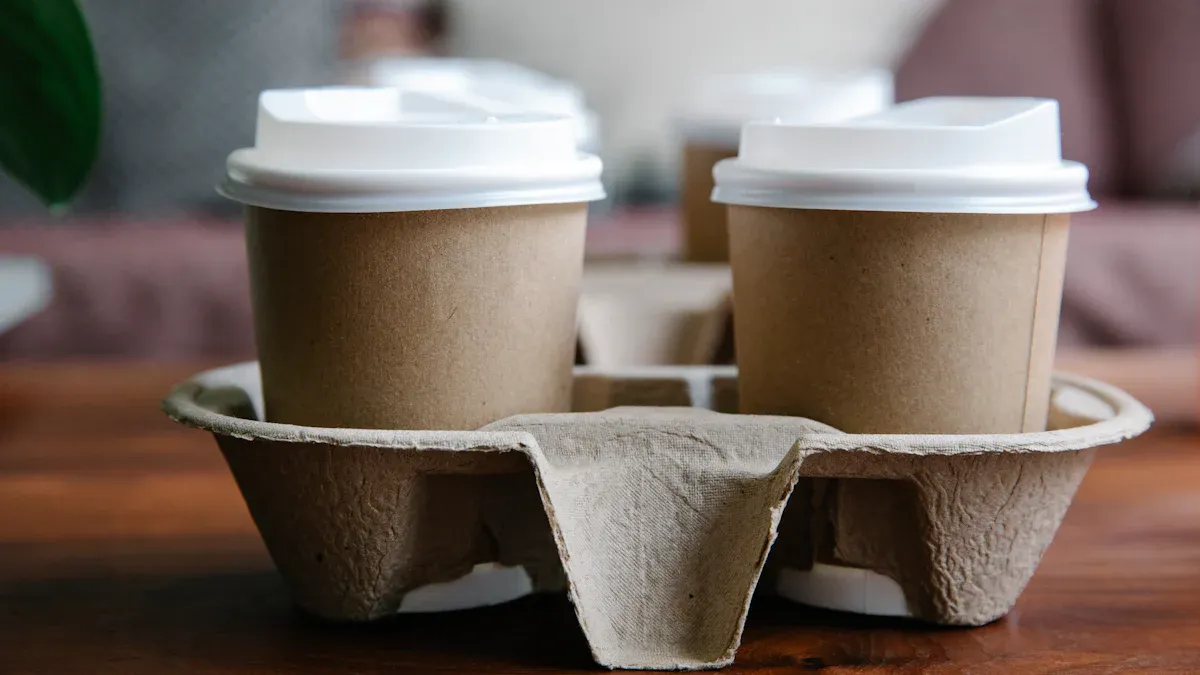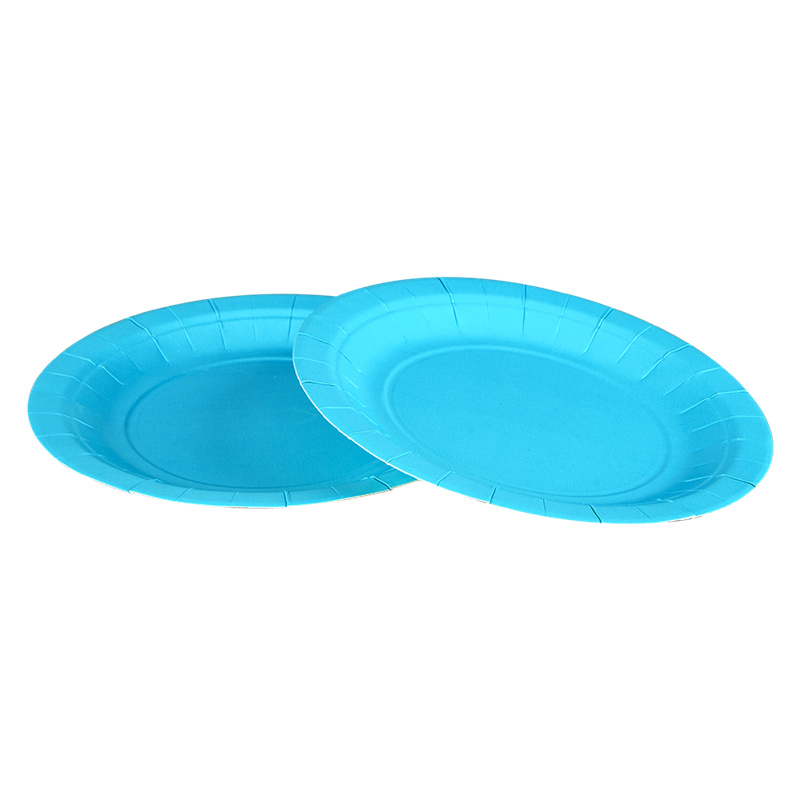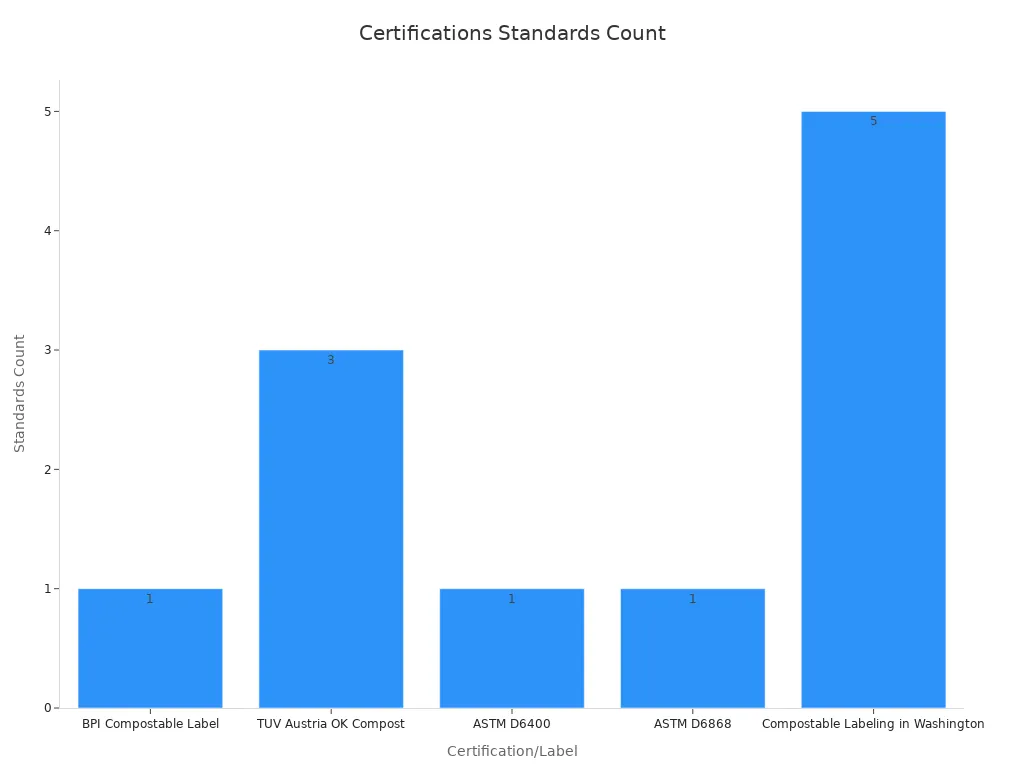
Biodegradable paper plates and cups are essential for promoting environmental sustainability. These eco-conscious products, including biodegradable paper plates and cups, naturally break down, helping to reduce waste and pollution. In 2023, the global market for biodegradable tableware, such as biodegradable bio paper plates, reached $15.27 billion, with an anticipated annual growth rate of 6.2% through 2030. Research highlights that bio-based materials, like those used in bio paper plate raw material, generate 45% fewer greenhouse gas emissions compared to traditional fossil-based options. Opting for biodegradable plates in bulk allows both individuals and businesses to embrace sustainability while significantly lowering their environmental impact. The use of high-quality bio paper plate raw material further enhances the eco-friendly nature of these products.
Key Takeaways
- Biodegradable plates and cups decompose naturally, cutting waste in landfills.
- Using biodegradable items lowers greenhouse gases more than plastic does.
- Picking biodegradable products protects animals and nature from pollution.
- Choose items made from bamboo or sugarcane for less harm to Earth.
- Buy certified biodegradable products to ensure they break down properly.
The Problem with Non-Biodegradable Alternatives
Environmental harm caused by plastic and Styrofoam
Non-biodegradable materials like plastic and Styrofoam cause significant environmental damage. Plastics accumulate in the environment at alarming rates, ranging from 5 to 275 kilograms depending on usage and disposal practices. Styrofoam, commonly used for packaging, contributes to pollution as it breaks down into microplastics that persist in ecosystems for decades. In Europe, nearly half of fish boxes made from Styrofoam end up in landfills, highlighting the widespread disposal issue.
Marine ecosystems face severe threats due to plastic waste. Each year, up to 12 million metric tons of plastic enter the oceans, equivalent to the weight of over 100,000 blue whales. This pollution impacts at least 267 species, including sea turtles, seabirds, and marine mammals. By 2050, ocean plastic is expected to outweigh all fish in the sea, creating irreversible damage to aquatic biodiversity.
Tip: Choosing biodegradable alternatives, such as biodegradable paper plates, can help reduce the harmful effects of plastic and Styrofoam on the environment.
Landfill overflow and waste management challenges
Landfills struggle to manage the growing volume of non-biodegradable waste. Improper waste separation exacerbates the problem, with only 13.1% of households sorting biodegradable and non-biodegradable materials. The remaining 86.9% mix both types, complicating recycling efforts and increasing landfill overflow.
| Evidence Type | Description |
|---|---|
| Waste Separation Rate | Only 13.1% of households separate biodegradable and non-biodegradable waste. |
| Mixed Waste Impact | 86.9% of respondents mix both types of waste, complicating waste management. |
| Health Risks | Improper waste storage leads to health hazards for local residents. |
| Landfill Operations | Over 300 tons of solid waste are dumped daily into unsanitary landfills. |
| Recycling Rates | Low levels of recycling for plastics and glass, with significant quantities accumulating in landfills. |
Landfills not only occupy valuable land but also release harmful chemicals into the soil and water. These chemicals pose health risks to nearby communities and disrupt local ecosystems. Unsanitary landfill operations, which process over 300 tons of waste daily, further amplify environmental risks.
Impact on wildlife and ecosystems
Non-biodegradable waste severely impacts wildlife and ecosystems. Plastic pollution kills one million seabirds annually and affects 86% of sea turtle species. Ingested microplastics disrupt hormones and reproductive systems in animals, leading to long-term population declines.
On land, plastic waste blocks water and air from reaching the soil, depleting nutrients and hindering plant growth. This disruption reduces biodiversity and creates barren landscapes. The widespread presence of non-biodegradable materials threatens the balance of ecosystems, making it harder for wildlife to thrive.
Switching to biodegradable products, such as biodegradable paper plates, can mitigate these issues. These eco-friendly alternatives decompose naturally, reducing waste and protecting wildlife from harmful pollutants.
Why Biodegradable Paper Plates Are Better

Natural decomposition and reduced waste
Biodegradable paper plates offer a significant advantage in their ability to decompose naturally. These plates break down into nutrient-rich soil within approximately 90 days. In contrast, traditional disposable plates, often made from plastic or Styrofoam, can take hundreds or even thousands of years to degrade. Instead of enriching the soil, they disintegrate into harmful microplastics that pollute the environment. This rapid decomposition of biodegradable paper plates reduces waste accumulation and minimizes the strain on landfills.
Switching to biodegradable options also helps communities manage waste more effectively. By choosing products that naturally decompose, individuals and businesses can contribute to cleaner surroundings and healthier ecosystems.
Note: Using biodegradable paper plates is a simple way to reduce waste and support sustainable waste management practices.
Lower chemical usage in production
The production of biodegradable paper plates involves fewer harmful chemicals compared to plastic alternatives. Manufacturers often use natural materials like bamboo, sugarcane, or recycled paper pulp. These materials require minimal processing, which reduces the need for toxic additives and synthetic compounds.
Plastic production, on the other hand, relies heavily on petroleum-based chemicals. These substances release pollutants into the air and water during manufacturing. By choosing biodegradable paper plates, consumers support industries that prioritize eco-friendly practices and reduce chemical pollution.
Smaller environmental footprint compared to plastic
Biodegradable paper plates have a smaller environmental footprint throughout their lifecycle. From production to disposal, these plates generate fewer greenhouse gas emissions. For instance, bio-based materials used in biodegradable products produce 45% fewer emissions than fossil-based plastics. This reduction helps combat climate change and lowers the overall environmental impact.
Additionally, biodegradable paper plates require less energy to manufacture. Their lightweight design also makes transportation more efficient, further reducing carbon emissions. By adopting these eco-friendly alternatives, individuals can make a meaningful difference in protecting the planet.
Tip: Choosing biodegradable paper plates in bulk can amplify these benefits, making them an excellent choice for both personal and commercial use.
Benefits of Using Biodegradable Products

Environmental Benefits
Biodegradable products offer significant environmental advantages over conventional materials. Unlike traditional plastics, which persist in the environment for centuries, biodegradable materials decompose naturally. This process improves soil quality and reduces pollution. For example:
- Microorganisms metabolize biodegradable plastics into CO2, CH4, and microbial biomass, leaving a minimal environmental footprint.
- These products are especially beneficial in situations where recycling or reuse is not feasible.
- By diverting waste from landfills, biodegradable materials help mitigate methane emissions and address the growing landfill crisis.
Switching to biodegradable options, such as a biodegradable paper plate, can also reduce the strain on waste management systems. These products break down quickly, minimizing the accumulation of harmful waste in landfills and ecosystems.
Practical Benefits
Biodegradable products provide practical solutions for everyday needs. They are lightweight, durable, and easy to dispose of, making them ideal for both personal and commercial use. Many biodegradable items, including plates and cups, are made from renewable resources like bamboo or sugarcane. These materials require less energy to produce, which lowers manufacturing costs and reduces carbon emissions.
Additionally, biodegradable products simplify waste disposal. Unlike traditional plastics, which require complex recycling processes, biodegradable items can be composted at home or in industrial facilities. This convenience encourages more people to adopt eco-friendly habits, contributing to a cleaner and healthier environment.
Social Impact
The adoption of biodegradable products positively influences communities and public opinion. Recent studies reveal that consumer attitudes toward bio-based materials play a crucial role in promoting sustainable practices.
Surveys show that positive emotions toward biodegradable products, such as bio-based packaging, increase their acceptance and usage. This shift in public perception can drive the transition toward sustainable industries, including healthcare and food services.
Communities that embrace biodegradable products often experience improved health outcomes. Reduced landfill waste and lower pollution levels create cleaner living environments, benefiting both people and wildlife. By choosing biodegradable options, individuals and businesses can support a global movement toward sustainability.
How to Choose and Where to Find Biodegradable Paper Plates
Tips for selecting high-quality biodegradable products
Choosing the right biodegradable paper plates requires careful consideration of several factors. These factors ensure the product aligns with environmental and practical needs.
| Factor | Description |
|---|---|
| Environmental Impact | Biodegradable plates decompose but still contribute to waste; their production has environmental costs. |
| Production Processes | The method of making biodegradable plates affects their overall sustainability. |
| Disposal Methods | Proper disposal is crucial; biodegradable plates may not degrade well in landfills, emitting methane. |
Consumers should also evaluate how the plates will be used. Single-use plates may lead to more waste, while reusable options reduce environmental impact. Proper disposal is equally important. Food residue on plates can hinder degradation, so cleaning before composting is recommended. While biodegradable options are better than traditional disposables, their environmental impact varies based on these factors.
Tip: Look for plates made from renewable materials like bamboo or sugarcane. These materials decompose faster and have a smaller carbon footprint.
Recommended retailers and brands
Finding reliable retailers and brands is essential for purchasing high-quality biodegradable paper plates. Many eco-conscious companies offer certified products that meet sustainability standards. Some popular options include:
- Eco-Products: Known for their durable and compostable tableware.
- Repurpose: Offers plates made from renewable materials like sugarcane.
- GreenWorks: Specializes in biodegradable and recyclable products.
Local stores and online platforms like Amazon and Walmart also provide a wide range of biodegradable paper plates. Customers should prioritize brands with transparent sourcing and manufacturing practices.
Note: Buying in bulk from trusted retailers can save money and reduce packaging waste.
Certifications to look for (e.g., compostable labels)
Certifications play a crucial role in identifying high-quality biodegradable products. These labels ensure the product meets specific environmental standards.
| Certification/Label | Description | Standards |
|---|---|---|
| BPI Compostable Label | Indicates that a product has passed ASTM 6400. | ASTM 6400 |
| TUV Austria OK Compost | Certifies compostability in home settings. | AS 5810, NF T 51800, EN 17427 |
| ASTM D6400 | Gold standard for compostable plastics. | ASTM D6400 |
| ASTM D6868 | Standards for biodegradable coatings. | ASTM D6868 |
| Compostable Labeling in Washington | Requires third-party certifier logo. | ASTM D6400, D6868, ISO 17088 |

Consumers should prioritize products with these certifications to ensure they are genuinely biodegradable and compostable. Labels like BPI Compostable and TUV Austria OK Compost guarantee the product will break down efficiently in composting environments.
Tip: Always check for third-party certifications to avoid misleading claims about biodegradability.
Biodegradable paper plates and cups provide an effective way to reduce waste and protect the environment. Their natural decomposition process minimizes pollution and supports healthier ecosystems. By choosing eco-friendly products, individuals can promote sustainable industries and reduce their environmental footprint. Small changes, like using a biodegradable paper plate, can inspire larger shifts toward sustainability. These efforts ensure a cleaner planet for future generations, proving that everyday choices have lasting impacts.
FAQ
What makes biodegradable paper plates different from regular disposable plates?
Biodegradable plates decompose naturally within months, unlike regular plates that persist for years. They are made from renewable materials like bamboo or sugarcane, which break down into non-toxic components, enriching the soil.
Can biodegradable paper plates be composted at home?
Yes, most biodegradable plates can be composted at home. Ensure they are free from food residue and certified for home composting. Plates made from bamboo or sugarcane pulp decompose faster in compost bins.
Tip: Check for certifications like TUV Austria OK Compost to confirm home compostability.
Are biodegradable plates safe for hot and cold foods?
Biodegradable plates are designed to handle both hot and cold foods. They resist heat and moisture, making them suitable for various meals. However, always verify the product’s temperature tolerance on the packaging.
How long does it take for biodegradable plates to decompose?
Biodegradable plates typically decompose within 90 to 180 days under composting conditions. Factors like temperature, moisture, and microbial activity influence the breakdown process.
Where can I buy biodegradable paper plates in bulk?
Many eco-friendly retailers offer biodegradable plates in bulk. Popular options include Amazon, Walmart, and specialized brands like Eco-Products and Repurpose. Buying in bulk reduces costs and packaging waste.
Note: Look for products with compostable certifications to ensure quality and authenticity.
By:hongtai
ADD:No.16 Lizhou Road,Ningbo,China,315400
Email:green@nbhxprinting.com
Email:lisa@nbhxprinting.com
Email:smileyhx@126.com
Phone:86-574-22698601
Phone:86-574-22698612
Post time: Apr-27-2025